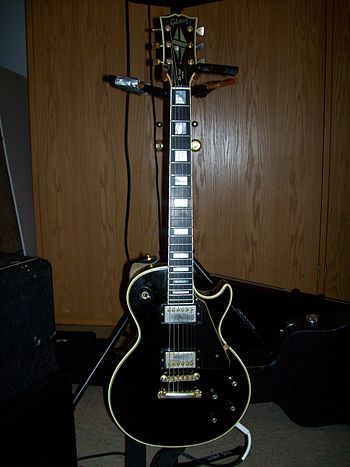 |
| A 1974 Gibson Les Paul Custom guitar. (Photo credit: Wikipedia) |
The Gibson Les Paul guitar was conceived at the very beginning of electric guitar history and has held its place at the forefront of guitar technology ever since. The two key elements that make the Les Paul guitars special are the vision of Les Paul himself, an eminent guitarist and enthusiastic inventor and the fact that the Gibson guitar company has always held extremely high standards of excellence for its instruments.
Les Paul is often credited with inventing the solid body electric guitar, and his involvement with the Gibson models was more or less just a happy accident. When he was a teenage performer he tried amplifying an ordinary acoustic guitar so that he could be heard by the audience. The feedback that resulted was finally eliminated by attaching the neck of an Epiphone guitar onto a block of wood. This was so strange looking that Les' musical talents were not taken seriously so he attached wings to the side of the wood so that it resembled a conventional guitar shape.
The moving force behind the financial and artistic success of the Les Paul guitar was the desire of the Gibson Guitar Corporation to market a solid body model electric guitar under the name of an established guitarist. By this time, the early 1950's, Les Paul was the most popular electric guitar player of the time. It would be a great triumph for Gibson to snare the endorsement of this guitarist who had conceived and made his own electric guitar which had become the basis for a solid electric guitar sold by his friend, Leo Fender. Eventually, after recommending some changes to the appearance of the new Gibson guitar, Les Paul allowed it to be released under his name.
There are a couple of design elements that stand out in the Les Paul range of guitars. The strings on a Les Paul guitar are mounted "hollow body style" on top of the guitar instead of passing through the body as is common with other brands of solid body guitars. This is merely a stylistic distinction, not affecting the sound of the guitar. The characteristic warm tone of the Les Paul guitars is due to the types of wood chosen by Gibson for these models. As we should expect from a guitar endorsed by the man whose own guitar design was nicknamed "the log", Les Paul guitars are also heavier and thicker than other solid body guitars. Both Les Paul and the Gibson corporation were fans of starting with substance and piling on heaps of style, so most Les Paul model guitars feature flashy inlays on the neck and headstock.
The Gibson Guitar Corporation has made many models under the Les Paul brand. Featuring names like Classic, Supreme, Standard, Studio Baritone, Studio, Goddess, Menace, New Century, Vixen, Special, Doublecuts and Melody Maker, each one has its own individual sound. Between 1969 and 1979 Gibson even marketed a range of Les Paul bass guitars. The Gibson Les Paul guitars have also been imitated by other companies such as Ibanez and Tokai. The legal wrangles surrounding these attempts at copying Les Paul guitars have only added to their collectibility.

No comments:
Post a Comment